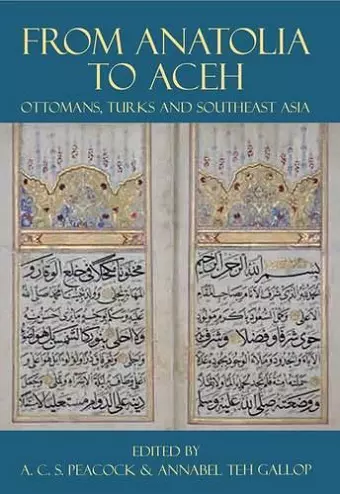From Anatolia to Aceh
Ottomans, Turks, and Southeast Asia
Andrew Peacock editor Annabel Teh Gallop editor
Format:Hardback
Publisher:Oxford University Press
Published:5th Feb '15
Currently unavailable, and unfortunately no date known when it will be back

Southeast Asia has long been connected by trade, religion and political links to the wider world across the Indian Ocean, and especially to the Middle East through the faith of Islam. However, little attention has been paid to the ties between Muslim Southeast Asia - encompassing the modern nations of Indonesia, Malaysia, Brunei, Singapore and the southern parts of Thailand and the Philippines - and the greatest Middle Eastern power, the Ottoman empire. The first direct political contact took place in the 16th century, when Ottoman records confirm that gunners and gunsmiths were sent to Aceh in Sumatra to help fight against the Portuguese domination of the pepper trade. In the intervening centuries, the main conduit for contact between these two regions was the annual Hajj pilgrimage, and many Malay pilgrims from Southeast Asia spent long periods of study in the holy cities of Mecca and Medina, which were under Ottoman control from 1517 until the early 20th century. During the period of European colonial expansion in the 19th century, once again Malay states turned to Istanbul for help. It now appears that these demands for intervention from Southeast Asia may even have played an important role in the development of the Ottoman policy of Pan-Islamism, positioning the Ottoman emperor as Caliph and leader of Muslims worldwide and promoting Muslim solidarity. The papers in this volume represent the first attempt to bring together research on all aspects of the relationship between the Ottoman world and Southeast Asia - political, economic, religious and intellectual - much of it based on documents newly discovered in archives in Istanbul.
The editors have done a remarkable job here in bringing together the work of historians and philologists to produce a volume of studies tightly focused along clearly defined axes of interaction between the two regions. Their efforts have produced a book that makes significant and meaningful contributions to our understandings of these trans-regional dynamics in the history of Southeast-Asia ... this fine volume will certainly serve as an important resource for work on this and other aspects of connection between the two regions in the future. * R. Michael Feener, Southeast Asian Studies *
The study of Ottoman influences on Muslim Southeast Asia has long been a dauntingly specialized field. In light of its linguistic, archival, and historiographic complexity, the field is likely to remain specialized and dauntingly multidisciplinary for some time to come. But it is precisely this complexity that makes this book's synthesis and depth such a welcome achievement, and a work important for all scholars intrigued by the history of Ottoman connections to Muslim Southeast Asia. * Robert W. Hefner, Indonesia journal *
ISBN: 9780197265819
Dimensions: 241mm x 164mm x 24mm
Weight: 816g
300 pages